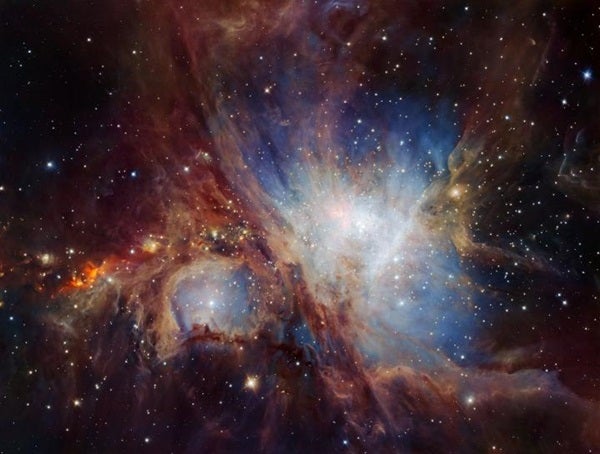The Orion Nebula (also known as M42) is one of the brightest nebulae in the night sky even visible to the naked eye; it appears as the middle “star” in the constellation Orion’s sword. This nebula is one of the most photographed objects in the night sky not only because it is beautiful but also has valuable insights into star and solar system formation as it is only 1,344 light years away. A new image taken by the VLT reveals never before seen low-mass objects hidden from view until now.
The High Acuity Wide-field K-band Imager (HAWK-I) on the VLT produced one of the deepest views seen of the Orion Nebula revealing faint brown dwarf stars and planetary-mass objects. Just the presence of these objects is exciting as they will provide insight into star formation within the nebula.
This image with its unexpected presence of low-mass objects suggests that the nebula may be forming proportionally more of these objects than the nearer, less active regions of star formation.
“Understanding how many low-mass objects are found in the Orion Nebula is very important to constrain current theories of star formation. We now realize that the way these very low-mass objects form depends on their environment,” says Amelia Bayo, professor at the Universidad de Valparaiso and a coauthor of the paper, in a press release.
By counting up how many objects of differing masses form in regions similar to the Orion Nebula, astronomers can attempt to understand how this star formation process occurs. Most objects were found with masses around one quarter of our sun’s mass before this study; now having found an overabundance of objects with masses much lower than this yields a second maximum in the distribution of star counts with these new low-masses found.
ESO’s future project of the European Extremely Large Telescpe (E-ELT), planned to begin building in 2024, is hoping to look at the number of planet-sized objects that may exist; as this research suggests, there may be more than first thought.
“Our result feels to me like a glimpse into a new era of planet and star formation science. The huge number of free-floating planets at our current observational limit is giving me hope that we will discover a wealth of smaller Earth-sized planets with the E-ELT,” says Holger Drass, a researcher at the Astronomisches Institut, Ruhr-Universität Bochum, in a press release.










